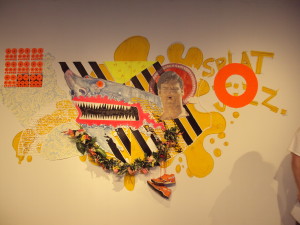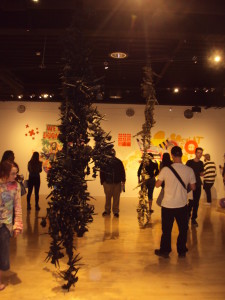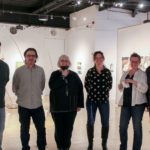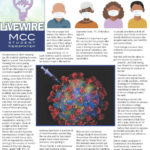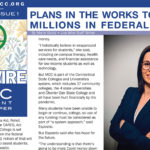‘Just Imagine’ Open Minds for Students and Faculty
By Olivia Jablonski, Live Wire Outgoing Editor-in-Chief
The Hans Weiss Newspace Gallery at Manchester Community College showcased an exhibition on Thursday, September 10, based off of artists’ thoughts, beliefs, and experiences that were influenced by perceptions of how they view the world and imagine it.
The artists participating in this “just imagine” exhibition peal back the skin of beliefs, and request and invite students, faculty, and other individuals to look beneath at what is most tender in their work of art.
“There’s an expectation that when people have an experience of creating art, there’s no way that we can look at a piece of visual of communication and not bring to it your own experiences and perceptions in where you are in the world,” Susan Classen-Sullivan, curator of the show said.
The exhibit included a broad range of mediums. From large wall collages, to a video, some drawings, photographs, and found objects sculptures, including objects that were generated by a 3D contemporary printer, Classen-Sullivan said.
“To get a sense of the artist’s experience, the viewer needs to spend some time with the work to sort of know what their own perceptions of where the artist is coming from,” Classen-Sullivan said.
Four artists featured their work and explained how their influences approached them to create a particular of art.
Colleen Coleman’s work illustrated pages from old books featuring epic landscapes that serve as the starting point. Over these pages are placed strips of metallic leather reminding us that we all have ‘skin in the game’ and that the cost of struggle, and losing it have been and will be huge and felt by all.
Her work stems from both hope and desperation, speaking of apocalyptic times, mass spiritual events, and the possibility of rescue or salvation, perhaps by beings from other worlds.
Political and geographic boundaries are probed in the work presented by Ted Efermoff. With his blood drawing, the blood is let by many as a consequence of the political decisions made by a few. How the lines are drawn by the heads of the nations can be at once arbitrary and devastating in their impact as it is shown in his work.
Silence is one of the main elements found in the work of Joseph Smolinski. Using 3D printing, Smolinski drew bees in which they reflected on advanced human capabilities; these bees suggest the possibility of redemption through acceptance and attention.
In Smolinski’s highly sensitive drawings, the wild beings are bugged with human surveillance equipment, portraying how terribly they are now subjected to life saving methods now used by the same source that caused their threatened extinction.
Margret Roleke’s work includes consumption, consumerism, and excess to all ideas of reality. The use of children’s toys draws attention to the stereotypical differences in girl toys and boy toys and the oddly sexualized Disney characters and Barbie dolls that are standard girl fare.
“Roleke’s work is probably the most intriguing work of art in this room that stands out to me,” Aysa Perez-Dean, a general studies student said. “The Barbie dolls just remind me of my childhood, and I still like Barbie today, but the meaning behind how the dolls are portrayed is something I have never would have thought of beforehand.”
The artists continue fulfilling one of the historic responsibilities of art by showing what goes unseen, or acknowledged and the consequences inherent to that blindness.
“To see beyond the mold of our individual ideas requires the ability, desire and courage, to imagine other possibilities,” Classen-Sullivan says. “I hope that the sense of fearlessness, as it is held in the work, and has been used by the artists, will be engaged in the viewer.
The exhibition will be open to the public now to October 22 in the Newspace Gallery.


